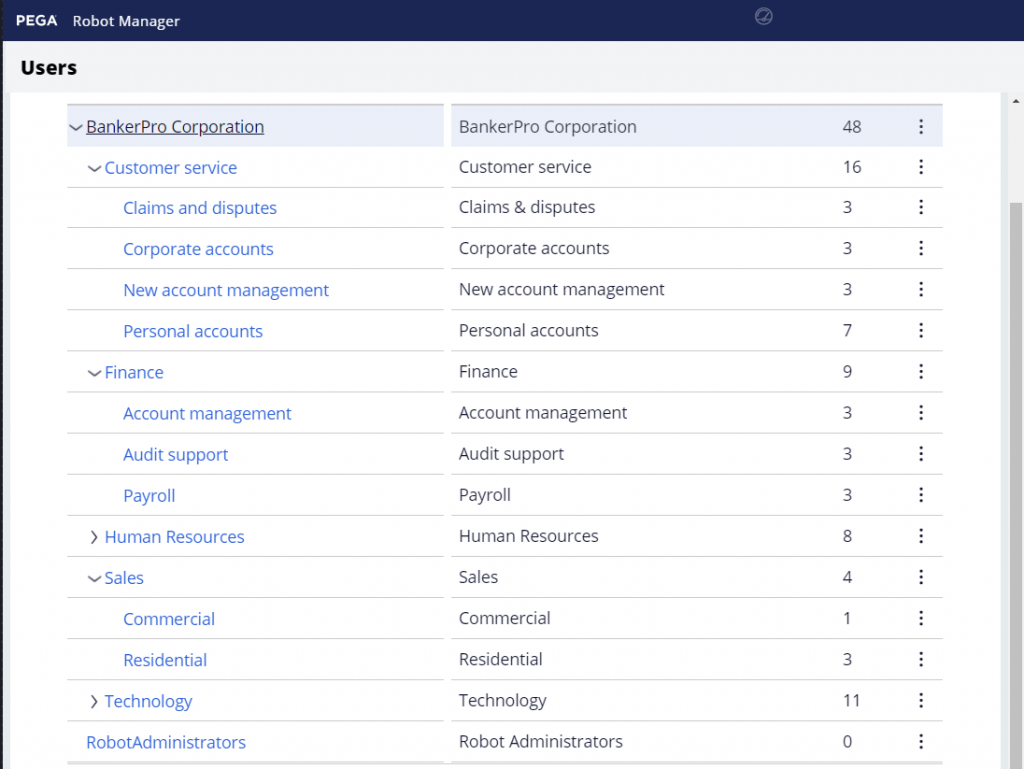
Organizational structure and hierarchy
Organizational structure creation
Creating and maintaining an organizational structure in Pega Robot Manager™ streamlines the assignment and deployment of packages as well as run-time configuration settings to users. This structure eliminates the need to access the users' desktop for attended robots directly. The organizational structure also helps to identify necessary updates to users' desktops for new versions of packages and corresponding run-time environments. Pega Robot Manager does this by communicating with a synchronization engine, which ensures the correct package and run-time version is downloaded to the users' desktop, based on the organizational structure package assignment and user membership.
Package and run-time configuration settings can be assigned directly to users if required, however, assigning these settings using the organizational structure offers a more scalable approach. Multiple users can belong to a single department. The assignments can only be applied to a parent-level department. The assignments automatically apply to the parents' child-level sub-departments. For example, an assignment made at a top-level department automatically applies to all sub-departments unless a different assignment is made at a lower level.
Tip: The organizational structure does not apply to unattended robots because the robots inherit packages and settings directly from the assigned work group.
The organizational structure is made up of departments and sub-departments. The structure is hierarchical and requires a minimum of three levels, but supports additional levels to offer more granular alignment between users and assigned packages. Each user belongs directly to one department. Packages are assigned to a department. This user-package relationship determines the packages to which users have access. Because the departments are hierarchical, users may access packages based on inheritance from a package assigned to a parent department.
The following image depicts a sample of the BankerPro Corporation organization. It includes three department levels and the number of users mapped to each department. Notice that users belong directly to a department at the lowest level, with the parent levels showing the number of users based on inheritance.
You can create or maintain the organizational structure either in Pega Robot Manager or Dev Studio. It is a best practice to create and maintain the structure in one tool. For example, if you create an organizational hierarchy in Pega Robot Manager, then maintain or edit the structure through Pega Robot Manager, not Dev Studio.
Note: In Dev Studio, the organizational structure uses the Org/Div/Unit terminology, while Pega Robot Manager refers to the org structure as departments and sub-departments.
Tip: As a Pega best practice, align your organizational structure with your company's HR structure.
Organizational inheritance
The organizational structure can also apply different run-time configurations within the hierarchy by customizing the RuntimeConfig.xml configuration file at each department level. For example, when users are placed in a department, users also inherit the department configuration settings or any parent department. When configured to do so, Pega Robot Runtime product versions are also updated through the Synchronization Server when users receive new package assignments or move to different departments. When users move to a different department, users disinherit the original department assignments and settings and instead apply the new department settings.
This Topic is available in the following Module:
If you are having problems with your training, please review the Pega Academy Support FAQs.
Want to help us improve this content?
